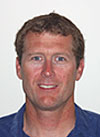
|
|
Scuttlebutt News:
(September 2, 2009) American Mike Martin first dabbled in 505s in the early 80ís, but it wasnít until 1996 when his connection to the class was fully solidified. That was when he began crewing with Howie Hamlin, leading the team to a Worlds win in 1999. At the 505 Worlds last week in San Francisco, Martinís hand was now on the tiller, and along with crew Jeff Nelson, the team dominated the 97 boat fleet, making Martin the first person in class history to win the Worlds from both ends of the boat. Scuttlebutt checks in with the new champion: I had done some 505 sailing with Macy Nelson when I lived in Virginia, and Macy introduced me to Howie when I moved to Long Beach, CA. Howie had a good crew at the time, and did not need another, so I just kept sailing my Finn. Then two years later, he called me up because he needed a crew and we sailed a regatta up at Richmond Yacht Club. We won the regatta and started sailing together after that. After Howie and I won the Worlds in 1999, I decided to set a goal of being the first person to win the 505 Worlds both as a skipper and a crew. I sailed the 2000 Worlds in South Africa with Steve Bourdow where we finished 2nd. After that I went back to crewing for a few years, but still had that goal. In 2004, Jeff and I teamed up for the Worlds in Santa Cruz and have been sailing together ever since. I don't know about freakish, but you are right, it's pretty uncommon to see one boat winning the majority of the races at a world championship, which is why I'm really proud of how we performed as a team, both tactically and with our boat speed. I honestly don't know what caused the speed differential. We have always been quick in overpowered conditions. I would say it most likely resulted from lots of practice as a team, plus we physically work the boat harder than most teams. It was really satisfying to win six of the nine races sailed after all of the time and effort we put into this campaign. Our Training consisted of sailing with our training group every Tuesday night in Long Beach (we call it Team Tuesday), and sailing regattas on the weekends. Howie and I started Team Tuesday in the mid-90s and it has been a great way to both train and introduce younger sailors into the fleet. This year we made lots of trips to San Francisco to get time on the Worlds race track. On non-sailing days we try to ride our mountain bikes, and I would sometimes sneak in a kiteboarding session when I could amidst the boat work. Jay and Pease Glaser have coached our Team Tuesday Group for years. Their input resulted in our continuous improvement to get us to Worlds winning form. We also had Euan McNichol, a past Worlds winner in the I-14, 29er and 18 Foot Skiff classes, coaching us during the regatta (along with the Howie Hamlin/Paul Cayard team). Regatta coaching is very different from practice coaching. One is about continuous skill improvement, and the other is about gathering and analyzing information about the conditions of the day. We did not expect to have to use it, but you have to be prepared for the unexpected. We had spent an inordinate amount of time preparing our boat for what we knew would be some of the toughest conditions we had seen at a Worlds in recent years. We had used the mast before and were confident with its speed. Our biggest concern was its age and if it would stand up to the week of harsh San Francisco conditions. I actually bought and rigged a new mast on the lay day just in case. We carefully inspected the mast everyday and luckily did not need the second spare. We were determined on the next day to wipe the slate clean and get right back into contention, so it felt great to cross the line in first on Day 2. We were sailing a 505 built in 1999 by Waterat (Larry Tuttle). It is not often a 10 year-old boat wins the Worlds, but Waterats are very well built and stay competitive a very long time. Our masts are Super Spar M2s. We broke our primary mast on the first day of the Worlds and had to switch to our spare for the bulk of the regatta. It has always been quick so we weren't so worried about its speed. We were just hoping that it was going to hold up all week since it was 10 years old as well. I designed the centerboard, which Larry Tuttle built. We also had a Waterat Carbon fiber boom and spinnaker pole, and we used a Glaser main, jib and spinnaker. Our whole boat is fitted with Ronstan Hardware. Well, you would think that with a bad global economy and with modern skiffs available that the class would suffer, but it is slowly growing both domestically and internationally. Each year, the Worlds attract some of the best sailors out there. This year, we had a bunch of Olympic medalists and former 505 Worlds winners, including San Francisco's own Paul Cayard. I believe that since the boat sails so well in so many conditions that it attracts and retains good sailors. In addition, this is just an incredible class of people. I truly enjoy spending time with 505 sailors - they are just a great group and I've gotten to meet and become friends with terrific people throughout the world. I have mixed feelings. On one hand everything else on the boat is carbon, so why not the mast? On the other hand, it will probably double the cost of a mast. The new mast we bought at the Worlds was about $1000, but I think that you can get them for a little less than that. I think that if the class is very careful on how they control the entry of a carbon mast that it can be done in a beneficial way for everyone. It is really not so different. You want to start on the favored side of the line, with no traffic below you. The biggest difference, and advantage, is that if you don't like your spot, you have time to sail up the line and look for a better one. Gate starts are great for big fleets. We only average about one general recall per Worlds. I believe that more fleets should use them - they are great for the sailors and for the race committee. 1996 5th Crewing 1997 3rd Crewing 1998 2nd Crewing 1999 1st Crewing 2000 2nd Driving 2001 6th Crewing 2002 2nd Crewing 2003 did not sail 2004 3rd Driving 2005 2nd Driving 2006 did not sail 2007 4th Driving 2008 6th Driving 2009 1st Driving 
Both Mike Martin, 44 years (right), and Jeff Nelson, 33 years, live in Newport Beach, CA. Click here for photos from the 2009 505 Worlds. back to top |







|


